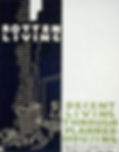How the New York City Housing Authority Used Modernism to Promote Public Housing
- Liz Publika
- Jul 1, 2018
- 3 min read
Updated: Dec 15, 2025
by Liz Publika
Mayor Fiorello Henry La Guardia (1882-1947) established the New York City Housing Authority (NYCHA) back in 1934. Today, it is widely considered to be one of the first municipal housing authorities in the United States. The agency relied on New Deal funds to clear out tenements that often had extremely dangerous living conditions, and build public housing was seen as a remedy to this problem. Ironically, people had to be persuaded to move.
Though tenement living was plagued by violence, disease and theft, public housing was still a radical new concept that most people rejected. The New York Times explains: “The idea of government-built housing was dangerously close to socialism, almost a cuss word at the time. But reformers drew on generations of disgust with the growing urban slums and the more recent Depression to mobilize for a new approach.” This wasn’t particularly difficult.
According to the Tenement Museum: “Allen Street stood as the neighborhood’s most notorious area for prostitution, most of which took place in tenements.” Because the police that were appointed to curb the crime instead chose to partake in it, not much was done about the widespread problems for years, both inside the tenements and the areas that surrounded them. And yet, people were resistant to what seemed like a sound alternative.
To promote public housing, artists were commissioned to design posters that highlighted the benefits of moving out of the city’s slums. City Lab put it best: “The posters consistently use an aesthetic that reflected the architecture of the projects, with modernist typefaces and geometrically based illustrations. Like much of 1930s modernism, there's a sense of confidence in the design, showing the failures of the past and present while presenting the viewer a better, purer future ahead.”
The resulting posters were quite extraordinary works of art. Featuring clear messaging and clever illustrations, they successfully sold the idea of public housing being the main answer to crime, pollution, and general degeneracy. And even if today public housing is not necessarily synonymous with quality living conditions in safe and patrolled neighborhoods, it is a blessing in disguise when compared to what came before.

Title: Eliminate Crime in The Slums Through Housing
By: the Federal Art Project
Published: September 12, 1936
Summary: Poster promoting planned housing as a method to deter crime in the slums, showing stylized man holding a gun against a backdrop of tenement buildings.

Title: Must We Always Have This? Why Not Housing?
By: the Federal Art Project
Published: September 12, 1936
Summary: Poster promoting planned housing as the solution to a host of inner-city problems, showing an inkblot on which are drawn elements of inner-city life.

Title: Cure Juvenile Delinquency in the Slums by Planned Housing
By: the Federal Art Project
Published: October 20, 1936
Summary: Poster promoting planned housing as a method to deter juvenile delinquency, showing silhouettes of a child stealing a piece of fruit and a child involved in armed robbery.

Title: Rotten Living/ Decent Living Through Planned Housing
By: the Federal Art Project
Published: between 1936 and 1938
Summary: Poster promoting planned housing as a solution to better living conditions in cities, showing a child standing in a alley with a trash can and cat rummaging through the garbage.

Title: Cross Out Slums
By: Lester Beall, Lester (1903 – 1969)
Published: U.S. Government Printing Office, 1941
Summary: Hand, representing United States Housing Authority, crossing out a slum.

Title: Slums Breed Crime
By: Lester Beall, Lester (1903 – 1969)
Published: U.S. Government Printing Office, 1941
Summary: Police leading man to patrol wagon in slum.
Note* All of the images and their descriptions are courtesy of the Prints and Photographs Division at the Library of Congress

